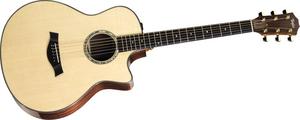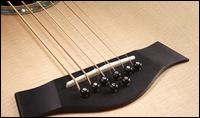Taylor GS Baritone Guitar
![]()
![]()
![]()
![]()
![]()
![]()
![]()
![]()

Taylor’s high-end guitars are just dripping with superlatives. They’re gorgeous to behold, rapturous to play and they sound like something the gods would own. Even the cases they come in are built with remarkable craftsmanship.
The Taylor GS Baritone is an unusual instrument – baritone guitars are a devious little back alley of instrument design. They’re tuned down such that what would normally be the high E string on a conventional guitar plays B. The rest of the strings are tuned accordingly. The result is a dark, throaty sound that can shake the earth.
In theory, you could arrive at much the same result with a conventional guitar by tuning it lower. In reality, this is little more than a theory – tuning a conventional guitar with conventional light strings down to B will result in something that flaps in the breeze and sounds like an early attempt to invent an automatic washing machine. Much heavier strings are called for, and mainstream acoustic guitars aren’t braced properly to use them. They also don’t have the correct scale length to play them with decent intonation. The results of trying to transform a standard acoustic guitar into a baritone instrument aren’t pretty, as a rule.
The Taylor Baritone has been designed with a top and braces that suit its place in the universe. It uses strings that start at 0.016 inches, rather than 0.012 for conventional light acoustic strings. While heavier, its strings aren’t unduly onerous to play, as they’re tuned with a lot less tension than would be case for a guitar tuned to E.
Taylor’s traditional laser-straight necks and perfect tops make the GS Baritone a peach to play. It’s as articulate as one of their high-end conventional acoustics – it just sounds like nothing you’ll have heard before. Its intonation is superb, even for a Taylor.
The GS Baritone is fitted with gold-plated Taylor tuners that are the equal of anything with a more recognizable brand name – they’re smooth and sufficiently robust as to stay put once you stop turning them.
As befits a high-end guitar, the GS Baritone has a sitka spruce top, and Indian rosewood back and sides. Its neck is mahogany. It has an ebony fingerboard. The sound hole rosette is cut from abalone. The workmanship that puts it all together is outstanding.
The GS Baritone is fitted with Taylor’s Expression pickup system… which also defies easy description. Acoustic guitar pickups have pretty much all been disastrous little mutants that made anything played through them sound like it was being rendered on a line of tuned soup tins. The Expression pickup in the GS Baritone is fairly stunning by comparison, in that it sounds like an expensive microphone poised in front of the instrument, rather than a transducer glued inside it. It’s difficult to tell that music recorded through its pickup started out electronically.

My Baritone GS has six strings – it’s probably worth mentioning that the Taylor Baritone is also available with eight. The eight-string version is a six-string instrument with doubled octave strings in the two center positions, similar to the way a twelve-string guitar is strung. A still more unique voice, the eight-string version is an interesting instrument if you play with a flat pick. Pretty much everything I play is finger-style, wherein those extra two strings would arguably just get confusing.
Only slightly larger than the Taylor 714ce Grand Auditorium guitar I’ve been playing since the dawn of time – and a lot smaller than a traditional dreadnaught acoustic – the GS Baritone is comfortable to hold. It’s compact size belies its voice – it can be a singularly expressive instrument, with a distinctive sound.
The Taylor GS Baritone ships with Elixir baritone strings, which suit what I like to play on it admirably. Aside from complimenting the sultry, expressive sound of the instrument, they’re resin coated – if you don’t break them, they’ll last for ages.
A great deal less work has gotten done herein since the GS Baritone arrived, and this may well be the case for some time to come. It’s intriguing to explore, and it seems to know innumerable tunes I’ve never heard before. It makes everything played on it sound new and engaging… and dark.
The GS Baritone does dark like it has a ninety-nine year lease on midnight.